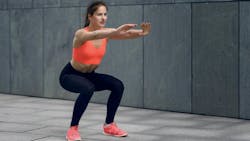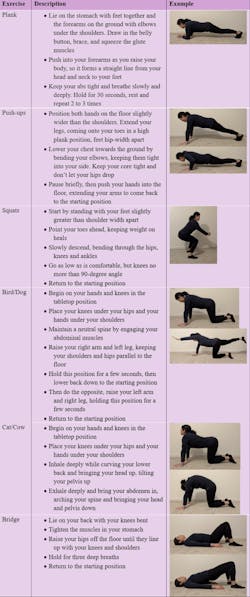Physical fitness to prevent musculoskeletal disorders in dental hygienists
Contributing authors:
Christina Calleros, MS, RDH
Justine Ponce, MS, RDH
Musculoskeletal disorders (MSDs) in the dental hygiene profession are extremely common, and the risk factors are endless. Some studies show that up to 96% of dental hygienists experience some work-related pain at some point in their career.1,2
Proper ergonomics are the leading preventive measure; however, there is research to show that physical fitness can also play a key role in the prevention of MSD. Regular exercise and strength training are areas of physical fitness dental hygienists should consider when striving to prevent MSD.
Exercise and strength training for prevention of MSDs
Being physically fit is defined as the ability to carry out daily tasks with vigor and alertness, without undue fatigue and with ample energy to enjoy leisure time pursuits.3 Being physically fit begins with physical activity. According to the CDC, physical activity is anything that gets your body moving, and it supports physical and mental health.4 Physical activity can mean many things, but should include regular exercise and strength training, also known as resistance training.
The many benefits of regular exercise and strength training include stronger bones and diminished joint stress, increased basal metabolic rate, increased bone density, reduced body fat and improved metabolism, better balance and coordination, improved cardiovascular health, enhanced cognitive function, and psychological well-being.5 Many studies have also shown that increased exercise and strength training can decrease musculoskeletal pain and disorders.6-9
As susceptible as dental hygienists are to MSDs, they should consider making regular exercise and strength training part of their daily and weekly routines. It is recommended that a person aim for at least 150 minutes of physical activity per week,4 such as walking, cycling, or swimming, with walking being one of the most common forms of activity, and it shows promise of improving lower back pain.9
It is also recommended that at least two days of strength training be done each week, with the goal of reaching all major muscle groups.4 While these are the recommendations, one study showed as few as 20 minutes three times weekly of strength training improved overall musculoskeletal-related pain.8 The same study also stated that increased muscle strength leads to improved working postures.
Other areas where RDHs develop pain
One area of the body where many dental hygienists have musculoskeletal pain is the lower back. Risk factors such as incorrect or static postures, standing or sitting for long periods of time, and awkward postures like leaning too far forward or to one side contribute to lower back pain.1,10 But multiple studies have demonstrated that maintaining strong abdominal muscles leads to stabilization, which can help dental hygienists reduce back injuries and MSDs in general.11-13 It’s important to perform abdominal exercises to build strong abdominal muscles. Exercises like cat/cow, bird/dog, bridges,14 and planks all help strengthen the abdominal and lower back muscles.
Although the back is a common area for dental hygienists to experience MSDs, other areas of the body can also be affected, so additional strength training exercises should be included as well. Exercises such as push-ups and squats strengthen other key muscles and strengthen multiple muscles at the same time. Push-ups are beneficial because they strengthen the upper body like the chest, shoulders, and triceps, aid in better posture, and increase shoulder and abdominal stability. Squats strengthen the leg muscles and aid in bone formation, help strengthen the abdominal and lower back muscles, and aid in improved posture and balance.15
Refer to Table 1 to for a variety of strengthening exercises accompanies by photos.
Due to the risk factors in the dental hygiene profession, dental hygienists are very prone to developing MSDs. However, being physically active is a key component in overall good health, and research is showing that it can be an important aspect of preventing MSDs.
Dental hygienists should focus on incorporating regular exercise and strength training into their routines. If they do this, there’s hope that along with proper ergonomics, they can prolong their careers and physical health.
Author’s note: Keegan Pomeroy, MS, RDH, completed this manuscript as a partial fulfillment for the Master of Science in Dental Hygiene Degree from the University of New Mexico, Division of Dental Hygiene. Christina Calleros, MS, RDH, and Justine Ponce, MS, RDH, are faculty members with the University of New Mexico, Division of Dental Hygiene.
References
1. Ng A, Hayes MJ, Polster A. Musculoskeletal disorders and working posture among dental and oral health students. Healthcare (Basel). 2016;4(1):13. doi:10.3390/healthcare4010013
2. Saccucci M, Zumbo G, Mercuri P, Pranno N, Sotero S, Zara F, Vozza I. Musculoskeletal disorders related to dental hygienist profession. Int J Dent Hyg. 2022;20(3):571-579. doi:10.1111/idh.12596
3. Caspersen CJ, Powell KE, Christenson GM. Physical activity, exercise, and physical fitness: definitions and distinctions for health-related research. Public Health Rep. 1985;100(2):126-31.
4. Physical activity basics: adult activity: an overview. Centers for Disease Control and Prevention. December 20, 2023. https://www.cdc.gov/physical-activity-basics/guidelines/adults.html
5. D'Onofrio G, Kirschner J, Prather H, Goldman D, Rozanski A. Musculoskeletal exercise: its role in promoting health and longevity. Prog Cardiovasc Dis. 2023;77:25-36. doi:10.1016/j.pcad.2023.02.006
6. Kell RT, Bell G, Quinney A. Musculoskeletal fitness, health outcomes and quality of life. Sports Med. 2001;31(12):863-873. doi:10.2165/00007256-200131120-00003
7. Roll SC, Tung KD, Chang H, Sehremelis TA, Fukumura YE, Randolph S, Forrest JL. Prevention and rehabilitation of musculoskeletal disorders in oral health care professionals: a systematic review. J Am Dent Assoc. 2019;150(6):489-502. doi:10.1016/j.adaj.2019.01.031
8. Holzgreve F, Fraeulin L, Maurer-Grubinger C, et al. Effects of resistance training as a behavioural preventive measure on musculoskeletal complaints, maximum strength and ergonomic risk in dentists and dental assistants. Sensors (Basel). 2022;22(20):8069. doi:10.3390/s22208069
9. De la Corte-Rodriguez H, Roman-Belmonte JM, Resino-Luis C, Madrid-Gonzalez J, Rodriguez-Merchan EC. The role of physical exercise in chronic musculoskeletal pain: best medicine–a narrative review. Healthcare (Basel). 2024;12(2):242. doi:10.3390/healthcare12020242
10. Ćwirzeń W, Wagner L. Evaluating the dental hygienists' exposure to the risk of musculoskeletal disorders. Eur J Dent. 2023;17(3):629-635. doi: 10.1055/s-0042-1750772
11. Parsons JL, MacDonald L, Cayer M, Hoeppner M, Titterton A, Willsie J, Webber SC. Functional fitness for dental hygiene students: does it make them fit to sit? Can J Dent Hyg. 2019;53(3):149-156.
12. Chang WD, Lin HY, Lai PT. Core strength training for patients with chronic low back pain. J Phys Ther Sci. 2015;27(3):619-22. doi:10.1589/jpts.27.61
13. Hunt AW, Lintag-Nguyen K. Promote ergonomic health. Dimensions of Dental Hygiene. November 18, 2021. https://dimensionsofdentalhygiene.com/article/promote-ergonomic-health/
14. Health and wellness: exercises and stretches. NIH. https://ors.od.nih.gov/sr/dohs/HealthAndWellness/Ergonomics/Pages/exercises.aspx
15. American sports and fitness association. The top 10 benefits of squats and lunges. https://www.americansportandfitness.com/
About the Author
Keegan Pomeroy, MS, RDH
Keegan Pomeroy, MS, RDH, is a full-time dental hygienist in Sacramento, California. She recently graduated from the University of New Mexico with a master’s in dental hygiene, with the goal of educating future dental hygienists. When not focusing on dental hygiene, Keegan enjoys traveling the world with her husband.

